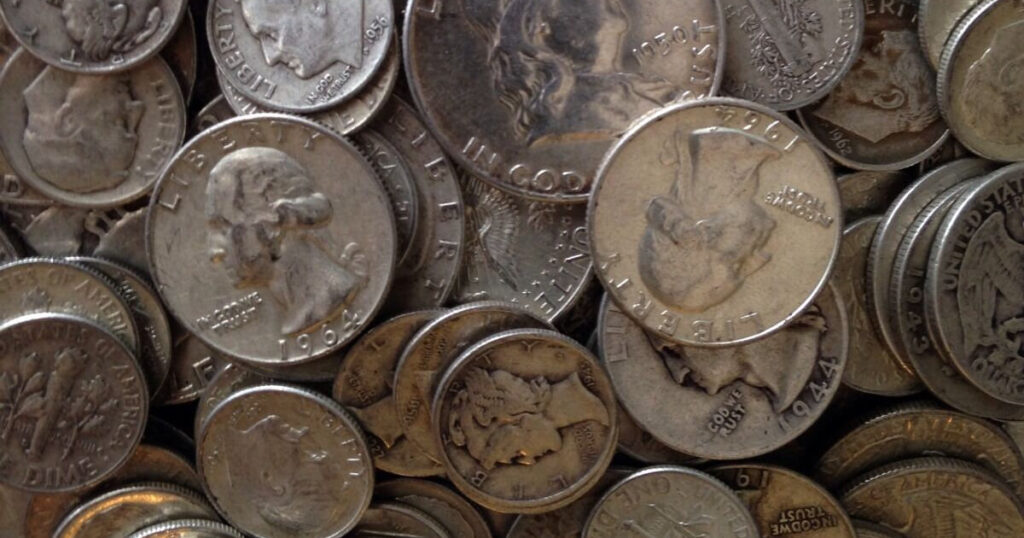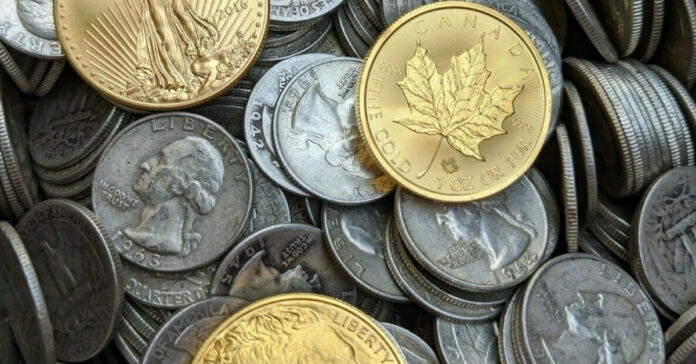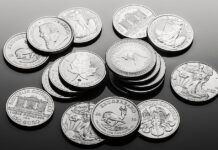NOTE: This article was originally posted in July 2020. Some updates were added in January 2024. Comments about premiums have not been changed and may be out of date. All prices in the article are the original price from 2020. As of January 20, 2024, Silver was selling at $22.50 and ounce and gold at $2029 an ounce, both down in the past week.
A friend called me and asked if I know anything about putting gold in their IRA. This led to a discussion about precious metals, why he wanted them, and how to best acquire them. I’m going to recap our discussion below as a Q&A.
First, a note: When I refer to precious metals or PMs, I mean gold and silver. If I mean one or the other, I will specify gold or silver. For many people, precious metals includes platinum, palladium and rhodium, but that is true for investing, not prepping.
Why? Because I find it unlikely that someone will recognize a one ounce bar of rhodium after the SHTF (sh*t hits the fan) and you want to trade it for a horse or a cow. I don’t think these other metals play a big role in prepping and survival, so this article is going to ignore them. I’m not saying don’t invest in them, I’m simply saying don’t do so thinking that they will help you prep.
Do Precious metals have value to a Prepper?
Yes, but only after you have invested in and taken care of the big three (food, water, and shelter) plus the next three (self-defense or guns and ammo, first aid, and communications). In other words, new preppers who only have a few months of food and a bug out bag can probably find more valuable things to spend their limited prepper budget before they buy any precious metals.
How can a prepper use PMs?
There are two primary reasons a prepper may want to have some PMs: As a replacement for money and as a store of wealth.
Because of their inherent value which is generally recognized around the world, using PMs as “money” or a medium of exchange after the banks have failed, make sense. When the electronic dollars in your accounts and investments have disappeared or are inaccessible, credit/debit cards no longer work, and the paper dollars in your wallet are not worth the paper they are printed on, you will need an alternative. Gold and silver are an alternative.
PMs as Money
Let’s imagine that you experienced a TEOTWAWKI (the end of the world as we know it) event and managed to survive. You are eeking out a living, barely managing to feed your family and keep from freezing to death. One day, your child gets bitten by a wild animal while removing what he thought was a dead body from a snare. The bite becomes infected, looks red, and the hand swells. You put antibiotic ointment on it, but it doesn’t do anything because the infection is too deep. Apparently, he needs some oral or intravenous antibiotics.
You know a guy who knows a guy who has some doxycycline he’ll sell you, but you don’t have anything he wants. Then you remember the roll of pre-1965 quarters you tucked away. You make a deal of 50 cents in junk silver per pill and buy 20, enough for your kid to have two per day for 10 days. Your son’s hand, and possibly his life, is saved.
Of course, you might also use silver for buying food, livestock, tools, firewood, help tilling the garden, etc., but I like to think of using PMs only when you have no other options or when two people cannot reach an agreement with barter alone. (For more on barter and trade in a post-SHTF world, we recommend the article How to Prosper in a Barter Economy.)
PMs as a Store of Wealth
PMs can also be used as a store if wealth. If there is a recovery some years after a TEOTWAWKI event, the money in your bank or the shares in your IRA may no longer exist. The companies you invested in may be gone. The exchanges they traded on may no longer exist. The cloud storage computers that held the data may never blink their LEDs and spin their hard drives again. However, the precious metals you have stored in your gun safe, buried in the back yard, hidden under that stone in your fireplace, or in your money belt will probably still have value. This could help you recover more quickly once the situation stabilizes.
In addition to being a store of wealth, PMs are an easily transportable form of wealth. Let’s say that you own six cows on your farm in Colorado but you want to travel to California to marry your sweetheart. You can’t take the cows with you. So you sell the cows for a one-ounce gold coin each. You can transport those to California pretty easily and likely use them to buy six cows once you get there, or whatever else you need to build your new life together.
What are the best PMs to buy?
I think this depends on your budget. Let me list them in the order in which I recommend you acquire them.
Junk Silver
The very first thing you should buy are U.S. dimes, quarters, and half–dollar coins dated 1964 and earlier. These are known as “junk silver” and are minted from a mix of 90 percent silver and 10 percent copper. $1 worth of these junk silver coins contains .715 ounces of silver. If you buy $100 worth of junk silver quarters (or dimes), they would contain 71.5 ounces of silver.

As of July 22, 2020, $1 in junk silver is selling for about $19. That means that $100 worth of junk silver quarters will cost you $1,900. Spot silver is $22.28 per ounce. If you do the math, 71.5 ounces of silver is worth only $1,592. The $308 difference is the premium you pay, and trust me, it is lower for junk silver than pretty much any other coin.
NOTE: Silver and gold prices fluctuate and have been rising lately. Check kitco.com or another PM site for current pricing.
The advantage of junk silver is that everyone can recognize a dime or a quarter, it is worth so little that no one is going to bother counterfeiting it, and there is lots of it out there. They also have a relatively low value, meaning it can be useful for buying small items and for making change, and someone is always willing to buy them from you, even if it is only at “melt value.”
I would recommend you get several hundred dollars (face value) worth of junk silver dimes and quarters and maybe a few rolls of half dollars before you look into anything else. So, for the sake of argument, spend your first $10,000 of your PM budget on junk silver.
January 2023 Update: There are many counterfeit Morgan and Peace dollars being produced in China. There may also be half-dollars and smaller coins. Avoid buying at flea markets and off Craigslist or Facebook Marketplace. If you are buying large quantities, buy from well known dealers or know how to test coins and spot counterfeits.
Silver Eagles and Other Silver Coins
American Silver Eagles are minted by the U.S. government and contain 1 ounce of .9999 fine silver. While you can buy these coins individually, they usually come 20 to a square plastic vial with a green lid. They are also sold in so-called “monster boxes” which contain 500 coins, but those are enormously expensive.
The advantage of Silver Eagles is a high recognition value and a high level of confidence that the coin actually contains an ounce of silver. The down side is that they tend to be more expensive than junk silver because they carry a higher premium. For example, 70 silver eagles, which is 70 ounces of silver, will cost you about $2,240 right now, much more than the equivalent silver in $100 (face value) of junk silver at $1,900.
If you do the math, the junk silver has a buyer’s premium of about $4 per ounce while the silver eagle has a buyer’s premium of about $9.25 per ounce. (As I write this, there is a shortage of silver coins in the market due to COVID-19, which is driving up the buyer’s premium. But while the premium is higher than normal, the premium on silver eagles is always higher than it is on junk silver.)
The Canadians also have a one-ounce silver coin, called the silver maple leaf. These come 25 to the tube, and their plastic tubes have a yellow lid. Right now, 70 ounces of silver maple leaves would cost you about $2,100. This makes the buyer’s premium about $6 per ounce, a nice compromise between junk silver and the American Eagle, but probably less recognizable to the general public than either.
Spend the next $5,000 to $10,000 of your PM prepping budget on American Silver Eagles, Silver Canadian Maple Leafs or a mix of both.
Only Buy Silver Coins Minted by the U.S., British and Canadian Governments
For prepping, I do not recommend silver coins minted by other countries. I do not recommend silver “rounds” which are coin-like objects produced by independent mints that are not affiliated with any government. (These may be fine for investing, but lack the recognition necessary for barter in a post-SHTF world.) Many of these rounds are designed to look like coins and may imply that they are made by the official U.S. mint, but they are not. For example, there is a silver buffalo round that looks like a larger version of what is known as the Indian Head nickel. This is a round and not a coin or legal tender. Rounds may make fine commemoratives and may be decorative, but if the person you are trying to sell it to or trade it with does not know how much silver is in it, its value goes down.







